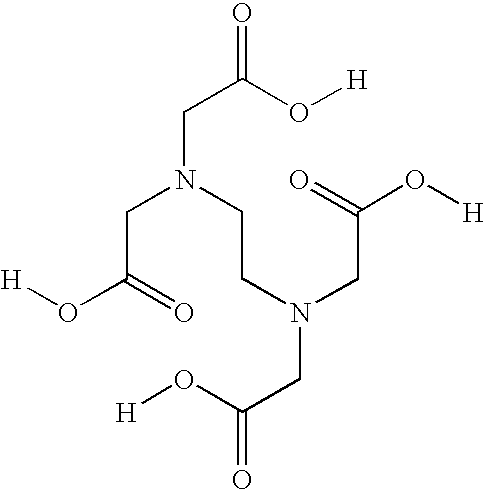Acetylcysteine composition and uses therefor
a technology of acetylcysteine and composition, which is applied in the field of acetylcysteine compositions, can solve the problems of oxidation and degradation of acetylcysteine, undesirable effects, and inability to stabilize acetylcysteine,
- Summary
- Abstract
- Description
- Claims
- Application Information
AI Technical Summary
Benefits of technology
Problems solved by technology
Method used
Image
Examples
example 1
Preparation of an Acetylcysteine Formulation
[0045]Twenty kilograms of acetylcysteine were added to approximately 60 liters of deaerated water for injection and the solution was mixed. A solution of sodium hydroxide was added to adjust the pH to approximately 6.5 to 7.0 and mixed until dissolved. A sufficient quantity of deaerated water for injection was added to make a 20% solution (total volume of 100 liters). Exposure to air was minimized by displacing oxygen with nitrogen. The solution was passed through a 0.2 micron sterilizing filter. The product was filled into vials or ampules and exposure to oxygen minimized by displacing the headspace with nitrogen.
example 2
Preparation of an Acetylcysteine Formulation
[0046]Add 10 kg of acetylcysteine to approximately 60 liters of deaerated water for injection and mix. Add a solution of sodium hydroxide to adjust the pH to approximately 6.5 to 7.0 and continue mixing until dissolved. Add a sufficient quantity of deaerated water for injection to make a 10% solution (total volume of 100 liters). Minimize exposure to air by displacing oxygen with nitrogen or other pharmaceutically inert gas. Pass the solution through a 0.2 micron or other sterilizing filter. Fill the product into vials or ampules minimizing exposure to oxygen by displacing the headspace with nitrogen or other pharmaceutically inert gas.
example 3
Stability of Acetylcysteine Compositions of the Invention
[0047]To determine whether the stability of acetylcysteine solutions required EDTA, three solutions containing different concentrations of edetate disodium were manufactured. The stability of a solution containing 0.05% edetate disodium, a solution containing 40% of that amount, 0.02% edetate disodium, and a solution containing no edetate disodium (0.00%) was examined. The three solutions were manufactured using similar processes to the process described in Example 1. Briefly, the edetate disodium, if any, was added in approximately 60% of the required deaerated water and mixed until dissolved. Acetylcysteine was then added and mixed until dissolved. The pH was adjusted to approximately 6.8 with sodium hydroxide and deaerated water was added to the target level. Nitrogen was used to purge the solutions. The product was then passed through a 0.2 micron filter to remove potential microbial contamination and was filled into vials...
PUM
| Property | Measurement | Unit |
|---|---|---|
| total volume | aaaaa | aaaaa |
| pH | aaaaa | aaaaa |
| stable | aaaaa | aaaaa |
Abstract
Description
Claims
Application Information
 Login to View More
Login to View More - R&D
- Intellectual Property
- Life Sciences
- Materials
- Tech Scout
- Unparalleled Data Quality
- Higher Quality Content
- 60% Fewer Hallucinations
Browse by: Latest US Patents, China's latest patents, Technical Efficacy Thesaurus, Application Domain, Technology Topic, Popular Technical Reports.
© 2025 PatSnap. All rights reserved.Legal|Privacy policy|Modern Slavery Act Transparency Statement|Sitemap|About US| Contact US: help@patsnap.com


